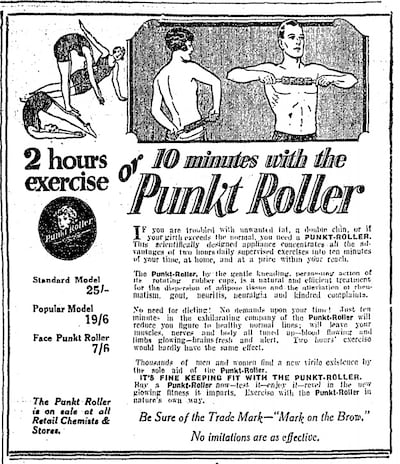Conflicting claims for different weight-loss regimes are no modern phenomenon. Another foray into the archives shows that diet fads and the search for quick-fix remedies have been around as long as The Irish Times.

It was 1863 when William Banting, an English funeral director, first publicised the weight-reduction method that had worked for him, a diet high in proteins and low in fats and carbohydrates. In an 1864 letter to the Editor, Banting argued that "sugar and saccharine matters are the chief cause of obesity".
The popularity of his approach was far-reaching. A snippet that same year informs us: "Mr Banting has been successful with the Princess Mary of Cambridge . . . through abstaining from bread, potatoes, and milk, her Royal Highness is much slimmer."
However, others declared Banting’s diet “humbug”. Addressing The British Association, a Dr Davy dismissed the obesity-correcting claims of the meat-based regime. One argument he forwarded was that the English had been particularly large consumers of meat, and Carrib cannibals could “distinguish an Englishman, and preferred him at their feasts, he being richer and more juicy”!

While Banting taught “fat makes fat”, Germany’s Prof Ebstein treatised in 1883 that fat is produced “merely by overeating and drinking”. His recommended daily menu shunned sugar, potatoes and turnips, but advised “plenty of butter”, soup (“frequently and with bone-marrow”), fat gravy and meat, a small quantity of vegetables and fruit, and “two or three glasses of light wine”.
Massage became another popular approach to weight reduction. The year 1877 brought news from Paris of actress Celine Montalaud’s “increasing embonpoint” . A Dr Gerard “undertook, by a course of kneading and pommeling” to reduce “her exuberant plumpness”. However, 240 treatments later Montalaud objected to a bill of 2,400 francs, claiming her obesity had increased. The doctor “asserted that the fault lay with Mademoiselle, in as much as she refused to follow his prescriptions, to eat sparingly, to rise before noon, and above all, to eschew suppers”.
‘Stoutness’ issues
Readers constantly sought advice from the paper's columnists for their "stoutness". In 1895 "Gipsy Countess" was told: "Avoid foods containing starch and sugar, and do not drink much with your meals. A glass of hot water before going to bed will be found beneficial . . ." As he did regularly, our medical correspondent also recommended Dr Nathaniel Yorke-Davies's book, Foods for the Fat. Yorke-Davies's most famous client was American president William Taft, and his "reducing diet" barred sugar and bread, and initially removed all fats, milk, cheese, cream and eggs. Laurent Perrier was just one company which used the doctor's name in promotions, claiming he found their "Sans Sucre Champagne invaluable in treating obesity by diet".
From about 1912 our health correspondent advised regularly on “How to Become Thinner”, telling readers to exercise and avoid all sweet dishes, potatoes and butter, café au lait or coca.
“A glassful of hot water with half a lemon squeezed into it” was to be sipped half an hour after every meal, and the time allowed for sleep was to be shortened, “for they who lie in bed in the morning will never become thin”.
That same year “The Conversations with a Sphinx” column advised that exercise was “the only means by which permanent relief from obesity can be obtained”. Walking, wood-chopping, Swedish gymnastics, bicycle riding, and “carefully-graduated mountain climbing” were all recommended, with the additional advice that, “exercise before breakfast is more effective that at any other time of the day”.
However, 40 years later, a health correspondent wrote: “Exercise does not make you lose weight. It helps your appetite and so makes you put it on.”
In 1914 an “Anxious Mother” was told to “get the boy into a drill class”, and to swing out of the crossbar to work off “superfluous fat”. Another reader was recommended Hunyadi Janos– a widely advertised “aperient” or laxative water.
‘Corpulence cure’
Advertisements targeting the overweight were common from the 1870s when “Allans Anti Fat” – an extract of seaweed – regularly appealed to the overweight reader. Kruschen Salts, meanwhile, purported to “melt away” “disfiguring” fat.
From the 1890s, FC Russell’s advertorials promoted his book and vegetable tonic. His “advice” included “eat as much as you like”, claiming his prescription could result in weight loss of up to 12lb a week! It apparently contained mainly citric acid – lemon juice – the chief ingredient in another popular “corpulence cure”, “Antipon”.
The new century brought an increased trend for female thinness, and the widespread use of unprescribed thyroid tablets as a weight-loss aid. There were warnings from the British Medical Association in 1927 but in 1932 a surgeon was still decrying their potential harm, appealing to the northern government to: "Save Ulster girls from 'slimming'."
The constant quest for a quick-fix solution – avoiding both exertion or deprivation – also brought “Obesity Soap”, used by “Madame Cordeax” on Molesworth Street in 1899. “Electric Light Baths” for weight-loss were fashionable in 1906, and Turkish baths in the 1930s. And in the 1920s the “Punkt Roller” targeted those “troubled with unwanted fat” .Two hours of exercise could be replaced by “10 minutes” with the “gentle kneading” of its rotating rubber cups. “No need for dieting.”

New diet fads were also heralded. An article in 1879 refers to the "common practice of young people taking vinegar to prevent obesity". In 1908 Prof F Moritz of Strasbourg pioneered his "Milk Diet" – just milk! And according to Dr Leonard Williams in 1919 only raw food would remove obesity-causing toxins from the body.
The fashion for a “non-sugar” diet in 1926 was even blamed for a world sugar glut. One sugar refiner commented: “We noticed a difference in this trade soon after this ‘get thin quick’ craze began, but we find consolation in the belief that it cannot last long. No woman – not even a stout one – can resist the lure of chocolate indefinitely.”
- This is part of a series looking at the archives of The Irish Times concerning health.
1) Sleeping secrets: undress in the dark
2) Cooking for invalids: wine and champagne
3) Eat fat, no milk: 19 rules of long living
4) Bloody cures for women's periods
5) Electrical cures to revive sluggish functions
6) Your 'flatulence' explain your 'noises'
7) Curing psoriasis with nude sunbathing
8) Weight-loss: Obesity soap and fat massage
9) Institution Dubliners hoped they'd never enter
10) Cocaine Tooth Powder





















